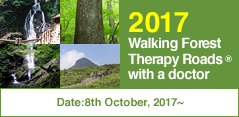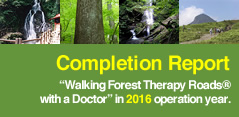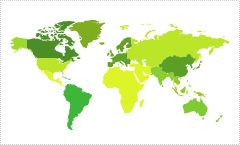INFOM Frequently Asked Questions
- What is INFOM’s purpose?
-
To spread awareness of the effectiveness of nature and forests in Western, Eastern, and traditional medicines, to create an organization which supports illness prevention and medical treatments, and to raise the level of Nature and Forest Medicine worldwide through the gathering of research data aimed at improving medical treatment, and by sharing research methodology internationally.
- What is INFOM?
-
INFOM is a recently established international medical association devoted to the advancement of welfare and integrated medical treatment, as well as to the advancement of the progress of the life sciences and development of medical equipment through continuing research in the emerging field of Nature and Forest Medicine.
- What is the history of INFOM?
-
INFOM began with the establishment of a research group focusing on forest therapy , which grew out of the cooperative efforts by government, industrial, and academic organizations in March 2004, which performed studies to further develop scientific understanding of forest bathing trips. Medical research involving forest bathing trips officially began with a research project initiated by the Ministry of Agriculture, Forests and Fisheries entitled “Illustration of the Physiological Effects of the Forest Element on Human Subjects”, which was conducted primarily at the Forest Research Institute, Chiba University, and Nippon Medical School. Afterward, we began the ‘therapy road’ in cities and towns nationwide to promote general acceptance of forest therapy, and now the therapy has become recognized in 42 different locations from Hokkaido to Okinawa. In addition, the Forest Medical Science Association was established with cooperation from the Japan Health Association, and is currently gathering research. The Forest Medical Science Association has since sponsored 3 research symposiums.
- What is a forest bathing trip?
-
The forest environment has been enjoyed by humans for a long time because of the quiet atmosphere, beautiful scenery, mild climate, and clean fresh air in forests. A forest bathing trip is a short, leisurely trip visiting a forest, called “Shinrinyoku” in Japanese. A forest bathing trip involves visiting a forest for relaxation and recreation. Incorporating forest bathing trips into a good lifestyle was first proposed in 1982 by the Forest Agency of Japan. It has now become a recognized relaxation and/or stress management activity in Japan.
- What are the stress-reducing effects of forest bathing?
-
According to results generated by experiments conducted in 35 nationwide locations with 400 subjects, compared with the subjects residing in cities, the stress hormone levels of subjects in forests measured by taking the cortisol concentrations in saliva were 12.4% lower. Also, while staying in the forests, blood pressure decreased by 1.4%, pulse decreased by 5.8%, which indicated that the forest bathing trips can alleviate stress symptoms. Furthermore, by measuring heartrate rhythm we found that parasympathetic nervous system activity increased by 5.0% and sympathetic nervous system increased by 7.0%, which indicated that forest bathing relaxes the body. Additionally, regarding 2 to 3 day forest bathing trips, stress hormone levels such as adrenaline found in subjects’ urine were found to be 38% lower in men, and 68% lower in women, and noradrenaline levels in men and women were 19.8% and 18.5% lower in men and women respectively. On forest bathing daytrips, cortisol concentration levels in blood were 18.5% lower.
- What is the effect of forest environments (forest bathing) on immune function?
-
It has been found that 2-night/3-day trips to forest parks increased human natural killer (NK) activity, NK cell numbers, and intracellular levels of perforin, granulysin (GRN), and granzyme A/B (GrA/B) in peripheral blood lymphocytes in both male and female subjects and the NK activity in male subjects increased 43% on day 2 and 56% on day 3, respectively during the forest trip compared with control day (before the forest trip). Moreover, this effect lasted for more than 7 days, even 30 days after the trip. In contrast, a city tourist visit did not increase NK activity, numbers of NK cells, nor the expression of selected intracellular anti-cancer proteins.
- What is the mechanism underlying forest bathing-induced improvement of NK activity?
-
Forest bathing increases human NK activity via the increases in the number of NK cells, and levels of intracellular anti-cancer proteins. Phytoncides released from trees and decreased stress hormones may partially contribute to the increased NK activity. Phytoncides released from trees increase human NK activity by two main mechanisms. The first mechanism is that phytoncides are inhaled by breathing and then absorbed into blood to directly act on NK cells. The second mechanism is mediated by reducing stress hormones. It is well known that stress hormones inhibit human NK activity.
- What is a hormone?
-
Hormones were first discovered by E. H. Starling in 1905. Hormones are produced by glands of the endocrine system and are transported to target organs mainly through the bloodstream, and then demonstrate actions through specific receptors.
- What are stress hormones?
-
Stress hormones are hormones for evaluating stress status, such as adrenaline and noradrenaline, which are released from the adrenal medulla, and cortisol, which is released from the adrenal cortex. It has been used to evaluate the body relaxing effects of forest therapy by measuring cortisol in the saliva and serum, and urinary adrenaline and noradrenaline.
- What is a white blood cell (WBC)?
-
WBC includes lymphocytes (T cells, B cells and NK cells), granulocytes (neutrophils, eosinophil, basophils) and monocytes (macrophages). Normal values of WBC are 3500-9700/μl. Generally, the sympathetic nerve increases WBC in peripheral blood, whereas parasympathetic nerve decreases WBC in peripheral blood. It has also been reported that dominance by the parasympathetic nervous system (under relaxing conditions) causes an increase in circulating lymphocytes and decrease in granulocytes in peripheral blood. It has been found that forest bathing trip significantly increased the proportions of lymphocytes and monocytes and significantly decreased the proportions of granulocytes in WBC count, suggesting that the parasympathetic nervous system of subjects was dominant. This is associated with relaxation and decreased stress.
- What are NK cells?
-
Natural killer (NK) cells can kill tumor cells naturally. There are CD16 and CD56 surface markers on the membrane of NK cells. NK cells are neither T cells nor B cells, but are a kind of lymphocyte. NK cells play an important role in immune surveillance, which protect the development, proliferation and metastasis of tumors, and in prevention of infectious disease and immune regulations.
- What are anti-cancer proteins?
-
NK cells kill tumor or virus-infected cells by the release of perforin, granzymes, and granulysin via the granule exocytosis pathway. Thus, perforin, granzymes, and granulysin are called anti-cancer proteins.




